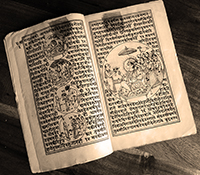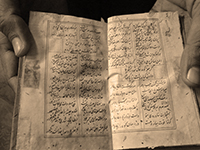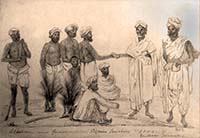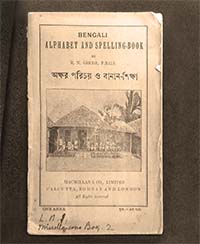About
Mapping the Spread of Print in South Asia
 This website maps the rise of the printing press across South Asia, from the establishment of the first movable type press in 1556 until the year 1900. Illustrating the impact of global technology transfer, chapakhana offers users the opportunity to visualize the extent of printing activity in the Indian subcontinent up until the end of the nineteenth century and to identify when printing first came to a particular location. In giving the names of early printing presses, along with their proprietors, printers, and editors, the website aims to make visible the many known and unknown pioneers of print in the Indian subcontinent. Taken together, the maps and additional materials on the website provide an extraordinary window into the vibrant world of printing in South Asia.
This website maps the rise of the printing press across South Asia, from the establishment of the first movable type press in 1556 until the year 1900. Illustrating the impact of global technology transfer, chapakhana offers users the opportunity to visualize the extent of printing activity in the Indian subcontinent up until the end of the nineteenth century and to identify when printing first came to a particular location. In giving the names of early printing presses, along with their proprietors, printers, and editors, the website aims to make visible the many known and unknown pioneers of print in the Indian subcontinent. Taken together, the maps and additional materials on the website provide an extraordinary window into the vibrant world of printing in South Asia.
 The subcontinent has a rich and diverse history of printing. Woodblock printing had been practiced in Tibet and the Himalayan regions centuries before Jesuit missionaries established the first movable type press in Goa in 1556. For the next 230 years, printing was dominated by Christian missionaries and remained largely confined to the coastal and southern regions.
The subcontinent has a rich and diverse history of printing. Woodblock printing had been practiced in Tibet and the Himalayan regions centuries before Jesuit missionaries established the first movable type press in Goa in 1556. For the next 230 years, printing was dominated by Christian missionaries and remained largely confined to the coastal and southern regions.
 It was only in the late eighteenth century that print came to east India, and it took several more decades before the first printing presses were set up in the north in the nineteenth century. With the expansion of the British Empire, print became an instrument of colonial rule and, subsequently, anti-colonial resistance. Calcutta, the new capital of British India, quickly grew into a hub of government and educational printing, while the mission press established in 1800 by Baptist missionaries in neighboring Serampore developed into the most important center of religious printing in Asia.
It was only in the late eighteenth century that print came to east India, and it took several more decades before the first printing presses were set up in the north in the nineteenth century. With the expansion of the British Empire, print became an instrument of colonial rule and, subsequently, anti-colonial resistance. Calcutta, the new capital of British India, quickly grew into a hub of government and educational printing, while the mission press established in 1800 by Baptist missionaries in neighboring Serampore developed into the most important center of religious printing in Asia.
 South Asia witnessed a rapid expansion of print in the nineteenth century as new printing technologies were imported from Europe in the wake of the Industrial Revolution. The advent of lithography (first introduced in Calcutta around 1820) and the iron handpress marked a watershed in local print history, rendering printing more accessible than ever before and enabling widespread Indian ownership of printing presses. Whereas lithography in Europe was chiefly used for map printing and for pictorial and musical representation, it became the preferred technology for book production across much of the subcontinent and led to a boom in regional language printing. By the second half of the nineteenth century, technical innovation, in combination with liberal press legislation and the spread of public education, had given rise to an indigenous print industry and ushered in the era of commercial printing—with mass-produced books, vernacular newspapers, and a flourishing textbook publishing sector. Print had now become a truly formidable cultural force.
South Asia witnessed a rapid expansion of print in the nineteenth century as new printing technologies were imported from Europe in the wake of the Industrial Revolution. The advent of lithography (first introduced in Calcutta around 1820) and the iron handpress marked a watershed in local print history, rendering printing more accessible than ever before and enabling widespread Indian ownership of printing presses. Whereas lithography in Europe was chiefly used for map printing and for pictorial and musical representation, it became the preferred technology for book production across much of the subcontinent and led to a boom in regional language printing. By the second half of the nineteenth century, technical innovation, in combination with liberal press legislation and the spread of public education, had given rise to an indigenous print industry and ushered in the era of commercial printing—with mass-produced books, vernacular newspapers, and a flourishing textbook publishing sector. Print had now become a truly formidable cultural force.
 The maps included here allow users to visualize how printing spread from coastal to inland regions and from the presidency capitals and large cities to small towns across the subcontinent. While the maps currently show only the earliest presses for most locations, the website provides more comprehensive data on the publishing landscape of several important early centers of printing—Benares (Varanasi,) Bombay (Mumbai,) Calcutta (Kolkata,) Lucknow, and Madras (Chennai). Given the historical time frame of the maps, place names reflect those prevalent in the colonial period. However, locations are also searchable by modern names and alternative spellings.
The maps included here allow users to visualize how printing spread from coastal to inland regions and from the presidency capitals and large cities to small towns across the subcontinent. While the maps currently show only the earliest presses for most locations, the website provides more comprehensive data on the publishing landscape of several important early centers of printing—Benares (Varanasi,) Bombay (Mumbai,) Calcutta (Kolkata,) Lucknow, and Madras (Chennai). Given the historical time frame of the maps, place names reflect those prevalent in the colonial period. However, locations are also searchable by modern names and alternative spellings.
Conceived and directed by Ulrike Stark, chapakhana is an ongoing project that seeks the input and collective expertise of scholars and students of book history, print culture studies, and cultural history across the globe. Chapakhana is designed as an informational and teaching resource. We hope to explore further aspects of South Asian print cultures and print technologies as this website expands.
